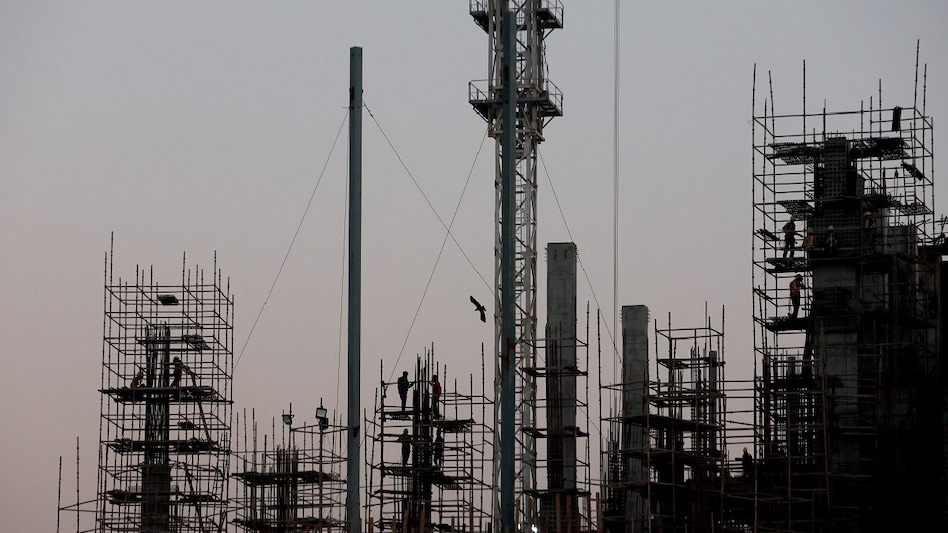 India's Q4FY22 GDP grows to 6.1%: Govt data
India's Q4FY22 GDP grows to 6.1%: Govt data
 India's Q4FY22 GDP grows to 6.1%: Govt data
India's Q4FY22 GDP grows to 6.1%: Govt dataIndia's economy grew 6.1% in the January-March quarter, accelerating from revised 4.5% in the previous quarter and 4.1% in Q4FY22 helped by a pickup in manufacturing activity, showed government data on Wednesday. For the 2022/23 fiscal year, economic growth was revised upwards to 7.2% from an earlier estimate of 7%. After this, the Indian economy is now $3.3 trillion in size.
Growth in the January-March period was higher than the revised 4.5% expansion in the previous October-December quarter of 2022-23. The growth was boosted by a 5.5% expansion in agriculture and a 4.5% growth in manufacturing. Other sectors of the economy - construction, services and mining - too posted handsome growth rates.
The Gross Domestic Product (GDP) had expanded by 4% in the January-March period of 2021-22, according to data released by the National Statistical Office (NSO).
As per the data, the economy expanded 7.2% in 2022-23 against a 9.1% growth in 2021-22.
The NSO, in its second advance estimate of national accounts, had pegged the country's growth at 7% for 2022-23.
China has registered an economic growth of 4.5% in the first three months of 2023.
A fall in food, crude oil and raw material prices boosted demand for services such as air travel and manufactured items like cars and mobile phones.
In the March quarter, India's manufacturing sector output rose 4.5% on-year, compared to 1.1% contraction in the previous quarter while farm output rose 5.5% compared to 3.7% growth in the same period.
"India's GDP for the January to March quarter has exceeded expectations, growing at a rate of 6.1% compared to the estimated growth of just above 5%. This positive development is certainly good news for the Indian economy. However, there are ongoing challenges for the fiscal year 2024, as the global economy is slowing down, leading to lower exports for India over the past three months. The lack of strong private capital expenditure also poses a hurdle for sustaining the same growth pace as in the previous fiscal year. In fact, several agencies have revised India's GDP forecast downward, and the uncertainty surrounding the monsoon further adds to potential headwinds that the Indian economy might face in FY24," said Sunil Damania, Chief Investment Officer, MarketsMojo.
According to the NSO data, the real GDP prices in 2022-23 are estimated to attain a level of Rs 160.06 lakh crore against the first revised estimates of GDP of Rs 149.26 lakh crore for 2021-22. ''The growth in real GDP during 2022-23 is estimated at 7.2% as compared to 9.1% in 2021-22,'' it stated.
Nominal GDP or GDP at Current Prices in the year 2022-23 is estimated to attain a level of Rs 272.41 lakh crore (USD 3.3 trillion), as against Rs 234.71 lakh crore ( USD 2.8 trillion) in 2021-22, showing a growth rate of 16.1%, it added.
The GDP at Constant (2011-12) Prices in Q4 2022-23 is estimated at Rs 43.62 lakh crore against Rs 41.12 lakh crore in Q4 2021-22, showing a growth of 6.1%. The GDP at Current Prices in Q4 2022-23 is estimated at Rs 71.82 lakh crore compared to Rs 65.05 lakh crore in Q4 2021-22, a growth of 10.4%.
Gross value added (GVA) growth during the fiscal ending March 2023 was 7% against an 8.8% growth in the preceding year.
The GVA growth in the manufacturing sector accelerated to 4.5% in the March 2023 quarter against 0.6% a year ago.
GVA growth in mining was 4.3% in the fourth quarter compared to 2.3% in the same quarter of the previous fiscal. Construction grew 10.4% in the quarter, up from 4.9% in the corresponding period of 2021-22. The agriculture sector growth accelerated to 5.5% from 4.1%.
The electricity, gas, water supply and other utility services segment grew 6.9% during the fourth quarter from 6.7% in the year-ago period.
GVA growth in the services sector -- trade, hotel, transport, communication and services related to broadcasting -- was 9.1% in the fourth quarter against a growth of five% a year ago.
Financial, real estate and professional services grew by 7.1% in the March 2023 quarter compared to 5.7% in the year-ago period.
Public administration, defence and other services posted 3.1% growth in the quarter against 5.2% expansion in the same quarter a year ago.
As per the data, the discrepancies factored while computing the national income was Rs 3,80,964 crore in 2022-23, lower than Rs 4,47,182 crore in the previous fiscal.
Rumki Majumdar, Economist, Deloitte India, said the GDP numbers were ''pleasantly surprising but not completely unexpected''.
''The strong rebound in manufacturing is the cherry on top since the modest recovery in the sector was a concern for policymakers,'' Majumdar said.
''Strong manufacturing and construction growth is encouraging because it is key to private investment in the coming quarters. With industry capacity utilisation rates and the government's capex spending reaching high levels, private investments will crowd in sooner than expected. High-frequency data on credit disbursement and light diesel oil consumption also suggest higher manufacturing activity in this fiscal.''
Sunil Sinha, Principal Economist, India Ratings and Research, said despite global headwinds, the growth momentum witnessed in FY23 is indicative of the Indian economy's resilience.
''However, the road ahead is not going to be easy so long as private final consumption expenditure (PFCE) does not recover fully and become broad-based. In fact, the real wage growth became nearly flat or even turned negative in some months of FY23 due to high inflation.
''Since much of the growth in consumption demand is driven by the wage growth of the household sector, a recovery in their wage growth is imperative for a sustainable economic recovery,'' he said.
With inputs from PTI